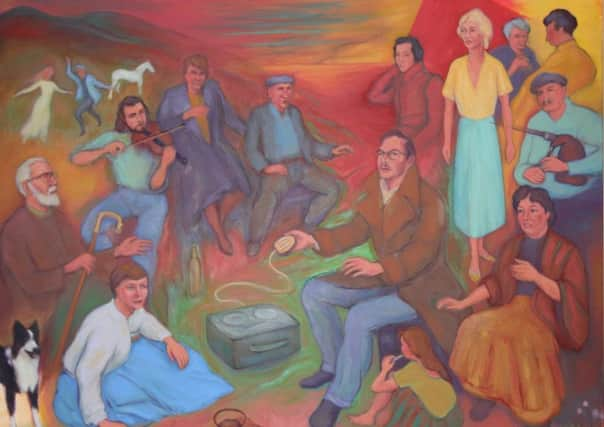Music: Legends of Scottish folk share a stage, courtesy of artist Alexander Moffat


Imagine a Perthshire landscape, bathed in vivid red and orange light, but also suffused with music and song and peopled by the carriers of Scotland’s rich folk music heritage. Such is the vision of Scotland’s Voices, a culturally resonant new painting by Alexander Moffat, which can be regarded as a companion piece to his famous canvas of 1980, Poets’ Pub.
Instead of the Rose Street makars clustered around Hugh MacDiarmid in their shadowy howff, Scotland’s Voices portrays some of the essential tradition bearers of the folk revival, many of them long departed. Among them are the travellers Jeannie Robertson and Belle Stewart, the incorrigible man of the road Jimmy MacBeath and the Border shepherd and crook-maker Willie Scott, as well as such important later, revivalist figures as Jean Redpath, Shetland fiddler Aly Bain and the piper and Gaelic scholar Allan MacDonald. They’re gathered round Hamish Henderson, the poet and folklorist regarded as a seminal influence in the revival, portrayed here as a young man, sitting with his trusty, song-gathering tape recorder. On a distant hillside a dancing couple have skipped their way out of David Allan’s famous Penny Wedding painting.
Advertisement
Hide AdAdvertisement
Hide AdAnother subject, happily still very much with us, is the Gaelic actress and singer Dolina MacLennan, who appeared to step out of the canvas to unveil it, wearing the blue and yellow in which she is portrayed, at a convivial gathering last month at the Saltire Society’s rooms in Edinburgh.
In the painting’s background, the Italian Marxist theorist Antionio Gramsci, whose letters from prison Henderson translated, can be seen debating with MacDiarmid – with whom Henderson conducted a famous “flyting” in the letters pages of this newspaper about the importance of folk music.
“That row in the letters columns of The Scotsman had a big impact,” says Moffat, an influential cultural commentator and former Head of Painting and Printmaking at the Glasgow School of Art, who still has cuttings of the letters. “MacDiarmid was a huge influence during my student years and his call for an ‘epic art’ struck a chord. “Folk music … seemed mundane by comparison. I really didn’t understand what Hamish was arguing about. That would take time.”
Poets’ Pub, which hangs in the Scottish National Portrait Gallery, was, says Moffat, “the culmination of a personal project based on early experiences of the Rose Street pubs and my friendships with some of the poets.” Executing a painting featuring the folk singers never crossed his mind, he adds, until three years ago when he was prompted by the filmmaker Douglas Eadie.
Initially Moffat was reluctant: “But the idea gradually became irresistible. I knew I had to do this.”
He spent a lot of time speaking to people who had known the characters in Voices of Scotland and listening to recordings: “Looking out old photographs of them wouldn’t be enough. I would have to fall in love with them in order to give them life on the canvas.”
That vividly glowing landscape – surely the beloved Glenshee of Henderson’s childhood – may be redolent of Tír na nÓg, land of the ever-young, but, says Moffat, also hints at the Western Desert, where Henderson served during the war and which inspired his Elegies for the Dead in Cyrenaica. It’s a natural companion piece to Poets’ Pub, and while discussions are continuing with the National Galleries of Scotland, there are no plans at the moment for it to be hung in the National Portrait Gallery, although both will go on display in Milngavie’s Lillie Art Gallery in January.
Advertisement
Hide AdAdvertisement
Hide AdIt seems only natural that the musicians should end up alongside the poets. There’s also a case, one can’t help thinking, for a companion Scotland’s Voices compilation recording – a challenge, perhaps, for a label such as Greentrax, who recently released their second volume of songs by another early revival figure, the songwriter Matt McGinn.
Scotland’s Voices can be viewed at the Saltire Society, Fountain Close, Edinburgh, Monday to Friday, until mid-September, 0131-556 1836.